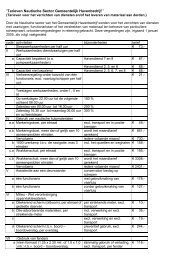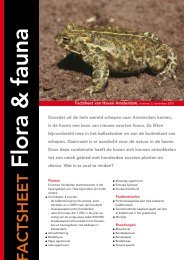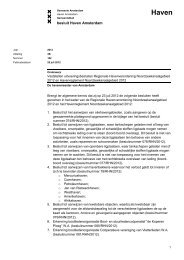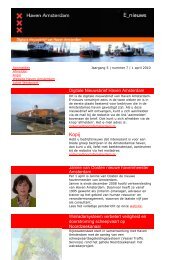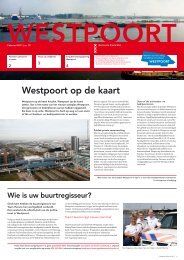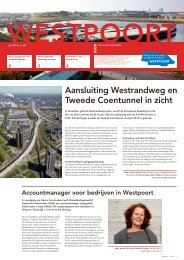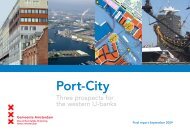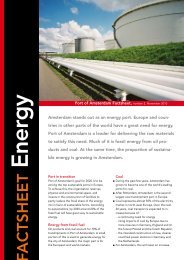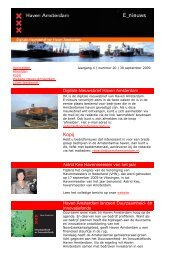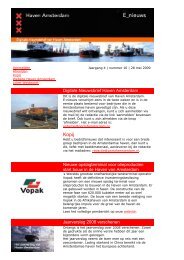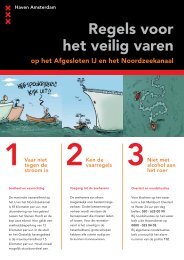You also want an ePaper? Increase the reach of your titles
YUMPU automatically turns print PDFs into web optimized ePapers that Google loves.
In <strong>2006</strong>, the growth achieved by the Amsterdam<br />
Port Area can be almost entirely attributed to the<br />
expansion of activities in the Port of Amsterdam,<br />
where cargo throughput rose by 13.4% to over<br />
61 million metric tons. In Amsterdam, oil products<br />
are one of the two booming sectors, growing by<br />
22% to more than 23 million tons. The other rapid<br />
grower is the container business, of course. While<br />
the volume of containers transshipped at the Port<br />
of Amsterdam is still limited (3.3 million tons), the<br />
growth in this sector can only be described as<br />
spectacular (from 66,000 to over 300,000 TEUs).<br />
Naturally, the cargo throughput in Amsterdam is<br />
very much linked to the local capacity for storage<br />
and transshipment. For example, the recent investments<br />
in the container terminal are now being<br />
reflected in the volume of containers handled by<br />
Amsterdam. More good news is that investments<br />
in container terminal capacity are continuing at<br />
an increased rate. In the year under review, the<br />
Port of Amsterdam leased out an impressive 80<br />
hectares of land (gross), which well exceeded<br />
the annual average of 25 hectares seen over many<br />
years. Important transactions were the lease of<br />
28.7 hectares to LBH/Rietlanden (for a new coal<br />
terminal in the Afrikahaven); 14 hectares to<br />
Handelsveem; 6.5 hectares to Oiltanking (which<br />
is further expanding its business); as well as<br />
9 hectares to Greenmills. These developments<br />
mean that the transshipment of coal and oil products<br />
will continue to grow in the coming years.<br />
Beyond that, the transshipment of bio-fuels will<br />
(partly parallel to the gasoline market) take off as<br />
a result of three initiatives taking shape in the port.<br />
In container transshipment, developments in recent<br />
months have shown that the Netherlands requires<br />
at least two but perhaps three full-fledged container<br />
ports to accommodate the strong growth in<br />
container shipping and to retain its market share.<br />
Remarkably, it is taking a long time for all participants<br />
in this chain to adjust their policies to the<br />
new reality. I expect the container business in<br />
Amsterdam to grow to 500,000 TEUs over 2007,<br />
and that new container shipping services will begin<br />
using Amsterdam in the future.<br />
The Ceres Paragon container terminal benefits the<br />
regional economy on two fronts. First of all, local<br />
companies are now making considerable savings on<br />
delivering goods to our seaport and picking them<br />
up here (reducing before-and-after transport).<br />
Beyond that, the large number of containers handled<br />
by this terminal is providing work for the local logistics<br />
and distribution sector. An example of this is<br />
a phased plan by a well-known property developer<br />
to build a 110,000-square meter ultramodern distribution<br />
center in Atlaspark on a risk-bearing basis.<br />
The continuing expansion at the port is also placing<br />
heavy demands on the port authority. We will have<br />
to put in an even greater effort to create optimum<br />
conditions for our customers. To further improve<br />
the port’s accessibility, the port authority is pushing<br />
vigorously for the speedy construction of a second<br />
major canal lock in IJmuiden, where the North Sea<br />
Canal discharges into the North Sea. The Port of<br />
Amsterdam and the Directorate-General for Public<br />
Works and Water Management will have to jointly<br />
develop methods for realizing this project as quickly<br />
as possible and on budget. Working under increased<br />
pressure only enhances our capacity for innovation,<br />
which has yielded substantial benefits<br />
in recent years.<br />
Furthermore, in all aspects of our operations, the<br />
subject of sustainable development will figure<br />
even more prominently. As a port, we aim to play<br />
a pivotal role in the regional, national and international<br />
economy. But we can only continue to do<br />
so, if we operate in a future-oriented fashion.<br />
Finally, I would like to thank the entire staff of the<br />
Port of Amsterdam for all their hard work and dedication<br />
over the past year.<br />
hans Gerson<br />
Executive Director and CEO



